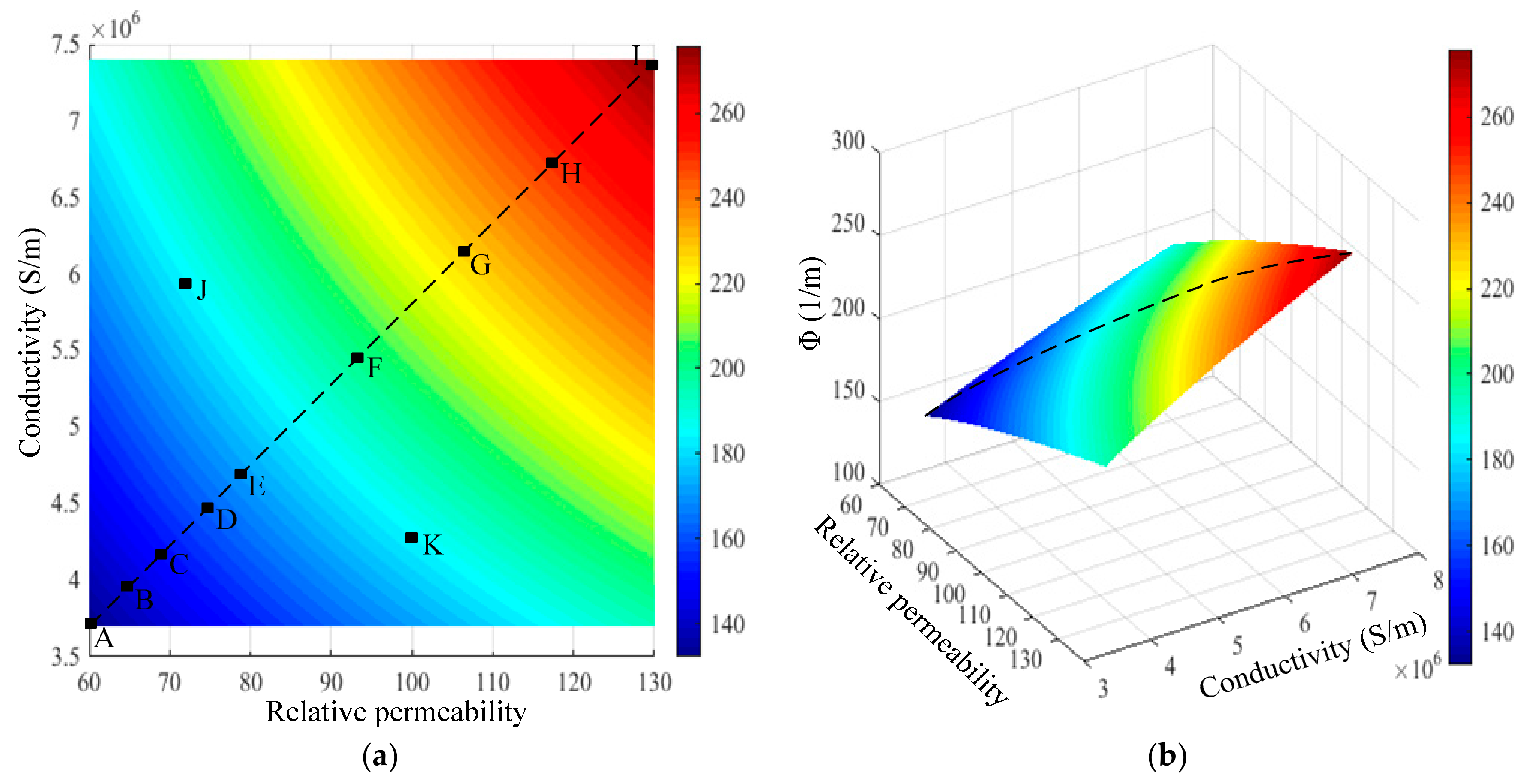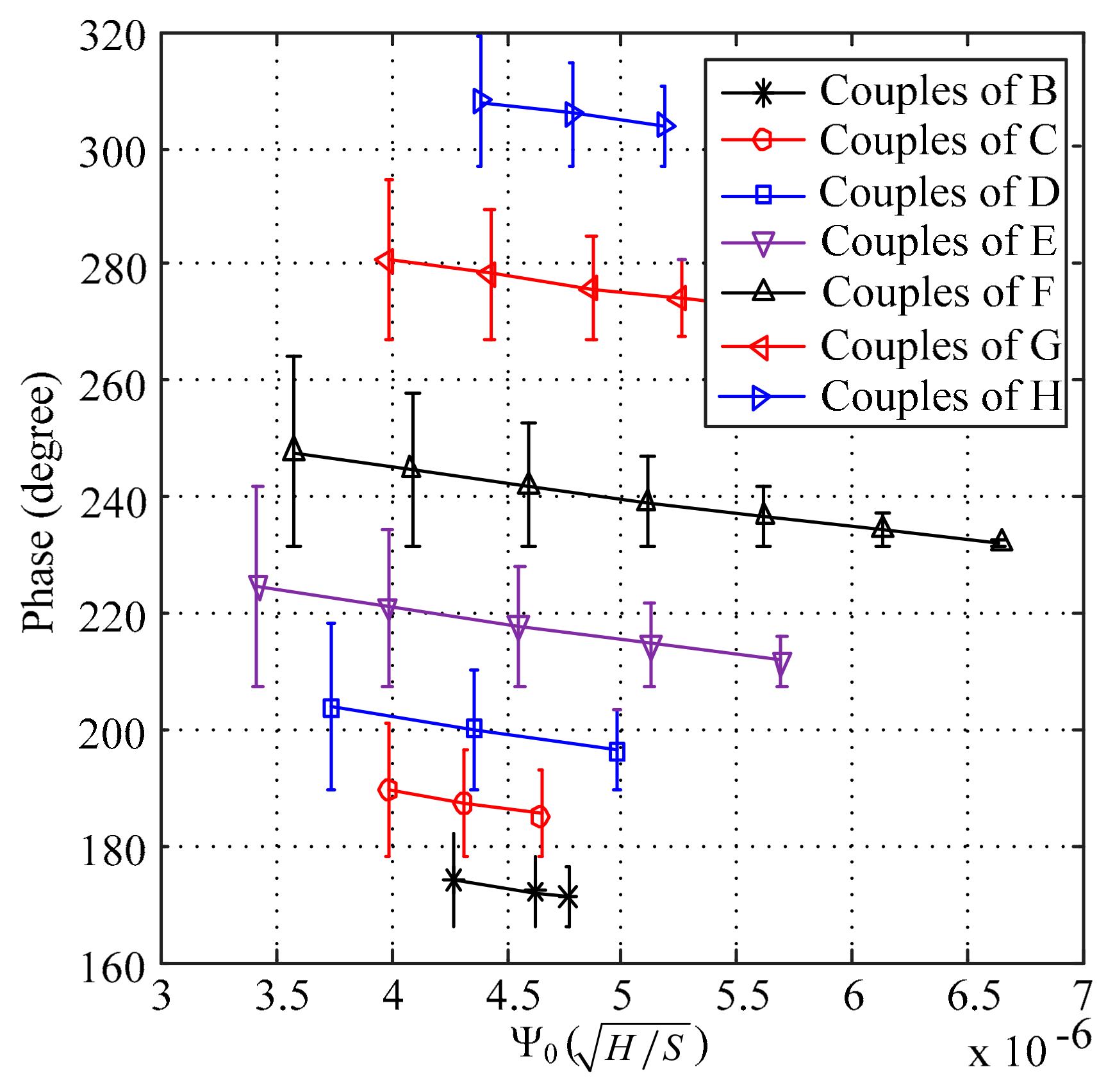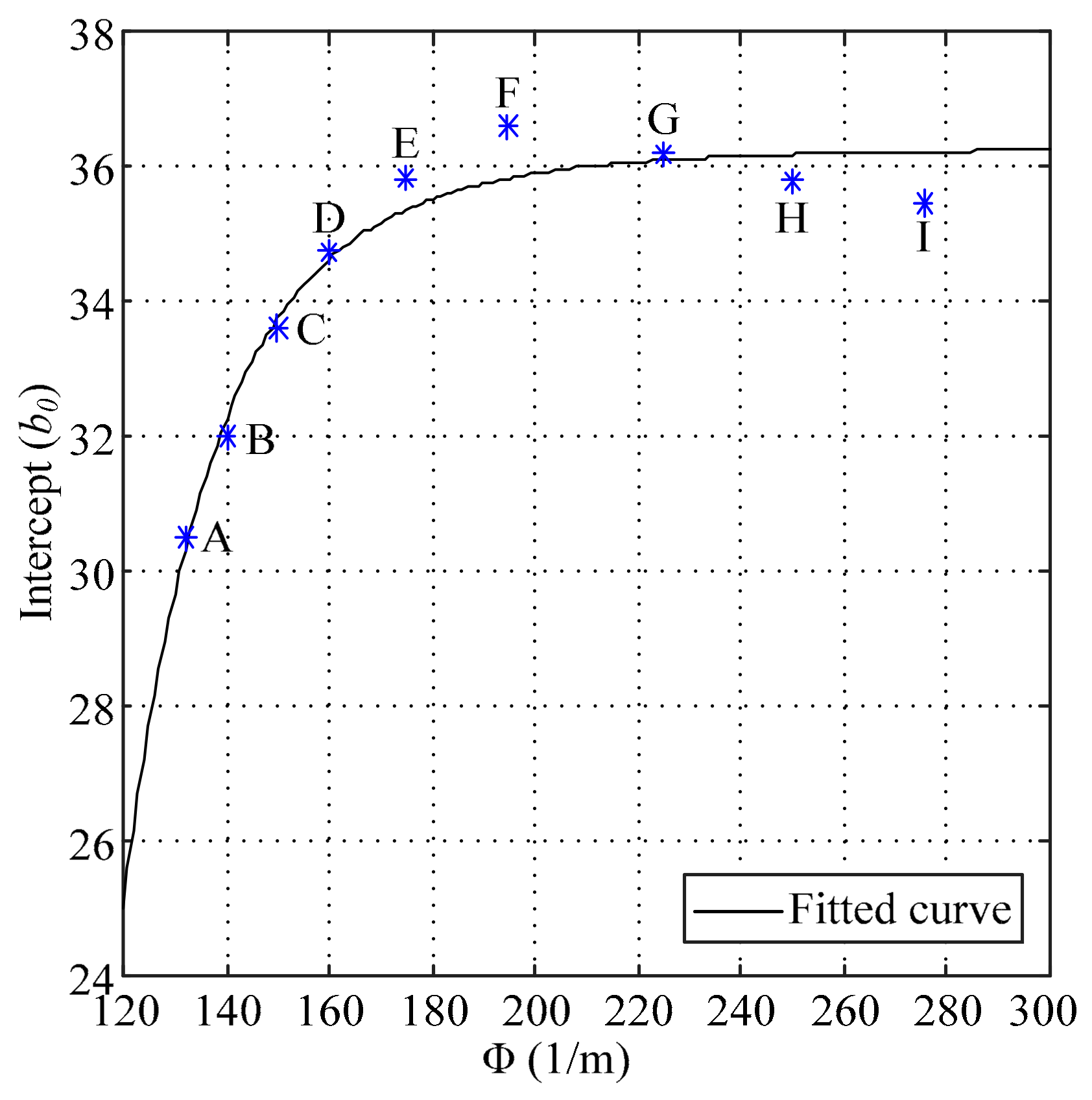A Study of Quantifying Thickness of Ferromagnetic Pipes Based on Remote Field Eddy Current Testing
Abstract
:1. Introduction
2. Methods and Models
2.1. Wall Thickness Analysis in RFECT of Pipes
2.2. Calibrations of RFECT Signal
2.3. Compensation Method Based on MFECT
3. Results and Discussion
4. Conclusions
Author Contributions
Funding
Acknowledgments
Conflicts of Interest
References
- Teitsma, A.; Takach, S.; Maupin, J.; Fox, J.; Shuttleworth, P.; Seger, P. Small diameter remote field eddy current inspection for unpiggable pipelines. J. Press. Vessel Technol. 2005, 27, 269–273. [Google Scholar] [CrossRef]
- Schempf, H.; Mutschler, E.; Gavaert, A.; Skoptsov, G.; Crowley, W. Visual and nondestructive evaluation inspection of live gas mains using the explore family of pipe robots. J. Field Robot. 2010, 27, 217–249. [Google Scholar]
- Gantala, G.; Krishnamurthy, C.V.; Balasubramaniam, K. Location and sizing of defects in coated metallic pipes using limited view scattered data in frequency domain. J. Nondestruct. Eval. 2016, 35, 1–13. [Google Scholar] [CrossRef]
- Xu, X.J.; Liu, M.; Zhang, Z.B.; Jia, Y.L. A novel high sensitivity sensor for remote field eddy current non-destructive testing based on orthogonal magnetic field. Sensors 2014, 14, 24098–24115. [Google Scholar] [CrossRef] [PubMed]
- Xu, X.J.; Peng, W.L. Rapid defect reconstruction based on genetic algorithm and similar model in remote field eddy current non-destructive testing. Appl. Mech. Mater. 2014, 1, 269–274. [Google Scholar] [CrossRef]
- Yu, K.L.; Hui, M.K.; Park, G.S. A study on the design of RFECT system for ferromagnetic pipelines. J. Korean Soc. Nondestruct. 2014, 24, 171–178. [Google Scholar]
- Ye, C.F.; Huang, Y.; Udpa, L. Novel rotating current probe with GMR array sensors for steam generate tube inspection. IEEE Sens. J. 2016, 16, 4995–5002. [Google Scholar] [CrossRef]
- Wang, J.; Yusa, N.; Pan, H. Evaluation of sensitivity of remote field eddy current testing and low-frequency eddy current testing for inspecting grooves of metal plate. Mater. Trans. 2013, 54, 90–95. [Google Scholar] [CrossRef]
- Yang, B.F.; Li, X.C. Pulsed remote field technique used for nondestructive inspection of ferromagnetic tube. NDT E Int. 2013, 53, 47–52. [Google Scholar] [CrossRef]
- Park, J.W.; Park, J.H.; Song, S.J.; Kishore, M.B.; Kwon, S.G.; Kim, H.J. Enhanced detection of defects using GMR sensor based remote field eddy current technique. J. Magn. 2017, 22, 531–538. [Google Scholar] [CrossRef]
- Ali, K.B.; Abdalla, A.N.; Rifai, D. Review on system development in eddy current testing and technique for defect classification and characterization. IET Circ. Devices Syst. 2017, 11, 330–343. [Google Scholar] [CrossRef]
- Xu, X.J. Research on novel remote field eddy current testing system for axial crack detection with high resolution. In Proceedings of the 2015 International Conference on Industrial Technology and Management Science, Tianjin, China, 27–28 March 2015. [Google Scholar]
- Gao, B.; Li, X.; Woo, W.L.; Tian, G.Y. Quantitative validation of eddy current stimulated thermal features on surface crack. NDT E Int. 2017, 85, 1–12. [Google Scholar] [CrossRef]
- Jarvis, R.; Cawley, P.; Nagy, P.B. Current deflection NDE for the inspection and monitoring of pipes. NDT E Int. 2016, 81, 46–59. [Google Scholar] [CrossRef] [Green Version]
- Fong, J.T.; Filliben, J.J.; Heckert, N.A. A Bayesian quantitative nondestructive evaluation (QNDE) approach to estimating remaining life of aging pressure vessels and piping. Rev. Prog. Quant. 2013, 1511, 1717–1724. [Google Scholar]
- Rosado, L.; Janeiro, F.M.; Ramos, P.M.; Piedade, M. Eddy currents testing defect characterization based on non-linear regressions and artificial neural networks. In Proceedings of the 29th Annual IEEE International Instrumentation and Measurement Technology Conference, Graz, Austria, 13–16 May 2013. [Google Scholar]
- Liu, B.L.; Hou, D.B.; Huang, P.J.; Liu, B.T.; Tang, H.Y.; Zhang, W.B.; Chen, P.H.; Zhang, G.X. An improved PSO-SVM model for online recognition defects in eddy current testing. Nondestruct. Test. Eval. 2013, 28, 367–385. [Google Scholar] [CrossRef]
- Tao, A.H.; Zhang, W.; Wang, Z.G.; Luo, Q.W. Design on forward modeling of RFEC inspection for cracks. In Proceedings of the 2014 International Conference on Information Science, Electronics and Electrical Engineering, Sapporo, Japan, 26–28 April 2014. [Google Scholar]
- Schmidt, T.R. Remote field eddy current inspection technique. Mater. Eval. 1984, 42, 225–230. [Google Scholar] [CrossRef]
- Gurleyen, H.; Mese, E. Analytical modeling of magnetically saturated inductance by lambert W function. J. Magn. 2017, 22, 369–377. [Google Scholar] [CrossRef]
- Xie, S.J.; Tian, M.M.; Chen, H.E.; Zhao, Y.; Wu, L.; Chen, Z.M.; Uchimoto, T.; Takagi, T. Evaluation of wall thinning defect in magnetic material based on PECT method. Int. J. Appl. Electrom. 2017, 55, S49–S59. [Google Scholar]
- Luo, Q.W.; Shi, Y.B.; Wang, Z.G.; Zhang, W.; Ma, D. Method for removing secondary peaks in remote field eddy current testing of pipes. J. Nondestruct. Eval. 2017, 36, 1. [Google Scholar] [CrossRef]
- Luo, Q.W.; Shi, Y.B.; Wang, Z.G.; Zhang, W.; Zhang, Y. Approach for removing ghost-images in remote field eddy current testing of ferromagnetic pipes. Rev. Sci. Instrum. 2016, 87, 104707. [Google Scholar] [CrossRef] [PubMed]
- Luo, Q.W.; Shi, Y.B.; Wang, Z.G.; Zhang, W.; Li, Y.J. A study of applying pulsed remote field eddy current in ferromagnetic pipes testing. Sensors 2017, 17, 1038. [Google Scholar] [CrossRef] [PubMed]
- Daniel, G.R.; Ovidiu, M.; Masashi, U. FEM comparisons between RF-ECT signals in quasi-static or transient and line. Int. J. Appl. Electromagn. Mech. 2012, 39, 297–303. [Google Scholar]
- Vasić, D.; Bilas, V.; Ambruškim, C. Validation of a coil impedance model for simultaneous measurement of electromagnetic properties and inner diameter of a conductive tube. IEEE Trans. Instrum. Meas. 2006, 55, 337–342. [Google Scholar] [CrossRef]
- Vasić, D.; Bilas, V.; Snajder, B. Analytical modelling in low-frequency electromagnetic measurements of steel casing properties. NDT E Int. 2007, 40, 103–111. [Google Scholar] [CrossRef]






| Point E (Φ = 175 (1/m)) | ANSYS Simulation | Calculated Results | |||
| Relative Permeability | Conductivity (MS/m) | Pipe Thickness (m × 10−3) | Simulated Phase (degree) | Pipe Thickness (m × 10−3) | Relative Error (%) |
| 60 | 6.465 | 10.36 | 224.85 | 11.21 | 8.22 |
| 70 | 5.541 | 10.36 | 221.21 | 11.03 | 6.48 |
| 80 | 4.848 | 10.36 | 217.85 | 10.86 | 4.83 |
| 90 | 4.310 | 10.36 | 214.78 | 10.71 | 3.38 |
| 100 | 3.879 | 10.36 | 211.93 | 10.57 | 2.01 |
| Point G (Φ = 225 (1/m)) | ANSYS Simulation | Calculated Results | |||
| Relative Permeability | Conductivity (MS/m) | Pipe Thickness (m × 10−3) | Simulated Phase (degree) | Pipe Thickness (m × 10−3) | Relative Error (%) |
| 90 | 7.124 | 10.36 | 280.79 | 10.89 | 5.12 |
| 100 | 6.412 | 10.36 | 278.29 | 10.79 | 4.18 |
| 110 | 5.829 | 10.36 | 275.93 | 10.70 | 3.30 |
| 120 | 5.343 | 10.36 | 273.70 | 10.62 | 2.47 |
| 130 | 4.932 | 10.36 | 271.60 | 10.53 | 1.68 |
| Point | B | C | D | E | F | G | H | Average |
|---|---|---|---|---|---|---|---|---|
| Slope ( × 106) | −5.876 | −6.038 | −5.935 | −5.670 | −5.161 | −5.188 | −5.208 | −5.582 |
| Point | A | B | C | D | E | F | G | H | I |
|---|---|---|---|---|---|---|---|---|---|
| Intercept () | 30.39 | 31.90 | 33.52 | 34.68 | 35.79 | 36.56 | 36.14 | 35.72 | 35.42 |
| Point M (Ψ0 = 4.244 × 10−6 ()) | Transfer Impedance | ||
| Relative Permeability | Conductivity (MS/m) | Amplitude (V) | Phase (degree) |
| 60 | 4.187 | 6.59 | 15.26 |
| 70 | 4.885 | 6.58 | 15.25 |
| 80 | 5.582 | 6.58 | 15.24 |
| 90 | 6.280 | 6.58 | 15.23 |
| 100 | 6.978 | 6.58 | 15.22 |
| Point N (Ψ 0 = 5.401 × 10−6 ()) | Transfer Impedance | ||
| Relative Permeability | Conductivity (MS/m) | Amplitude (V) | Phase (degree) |
| 90 | 3.877 | 7.05 | 12.62 |
| 100 | 4.308 | 7.05 | 12.62 |
| 110 | 4.739 | 7.04 | 12.61 |
| 120 | 5.169 | 7.04 | 12.61 |
| 130 | 5.600 | 7.04 | 12.61 |
| Relative Permeability | Conductivity (MS/m) | Real pipe Thickness (m × 10−3) | Before Calibration | After Calibration | ||
|---|---|---|---|---|---|---|
| Pipe Thickness (m × 10−3) | Relative Error (%) | Pipe Thickness (m × 10−3) | Relative Error (%) | |||
| 60 | 6.465 | 10.36 | 11.21 | 8.22 | 10.40 | 0.39 |
| 70 | 6.880 | 10.36 | 11.09 | 7.05 | 10.38 | 0.19 |
| 90 | 7.124 | 10.36 | 10.89 | 5.12 | 10.35 | 0.10 |
| 110 | 7.196 | 10.36 | 10.75 | 3.76 | 10.34 | 0.19 |
| 130 | 7.400 | 10.36 | 10.65 | 2.80 | 10.34 | 0.19 |
| 60 | 7.400 | 10.36 | 11.24 | 8.49 | 10.41 | 0.48 |
| 130 | 3.700 | 10.36 | 10.38 | 0.19 | 10.44 | 0.77 |
| 60 | 7.400 | 8.36 | 9.18 | 9.81 | 8.35 | 0.12 |
| 100 | 5.550 | 12.36 | 12.72 | 2.91 | 12.33 | 0.24 |
© 2018 by the authors. Licensee MDPI, Basel, Switzerland. This article is an open access article distributed under the terms and conditions of the Creative Commons Attribution (CC BY) license (http://creativecommons.org/licenses/by/4.0/).
Share and Cite
Zhang, W.; Shi, Y.; Li, Y.; Luo, Q. A Study of Quantifying Thickness of Ferromagnetic Pipes Based on Remote Field Eddy Current Testing. Sensors 2018, 18, 2769. https://doi.org/10.3390/s18092769
Zhang W, Shi Y, Li Y, Luo Q. A Study of Quantifying Thickness of Ferromagnetic Pipes Based on Remote Field Eddy Current Testing. Sensors. 2018; 18(9):2769. https://doi.org/10.3390/s18092769
Chicago/Turabian StyleZhang, Wei, Yibing Shi, Yanjun Li, and Qingwang Luo. 2018. "A Study of Quantifying Thickness of Ferromagnetic Pipes Based on Remote Field Eddy Current Testing" Sensors 18, no. 9: 2769. https://doi.org/10.3390/s18092769





